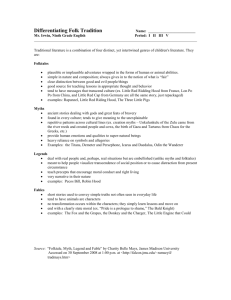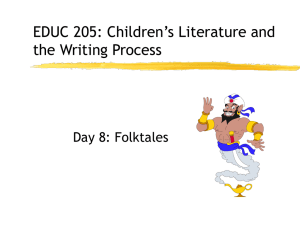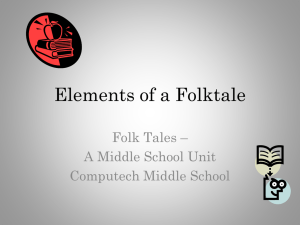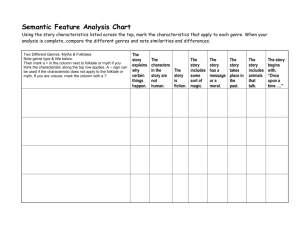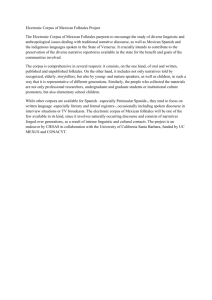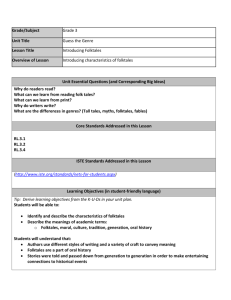What is a folktale?
advertisement
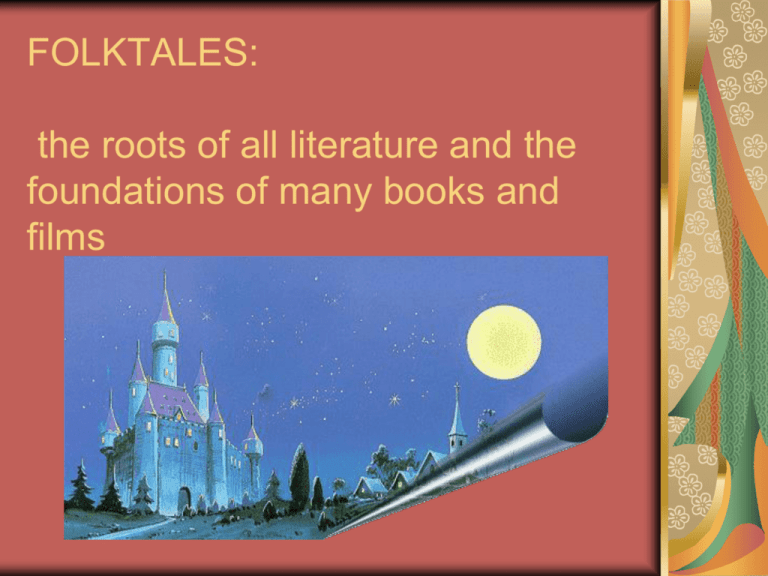
FOLKTALES: the roots of all literature and the foundations of many books and films Folktales: speak to humans’ basic emotions, to our most minor as well as horrific fears and to our deepest hopes assume the audience is familiar with tradition, beliefs, and cultural norms. are embedded in the cultures so it is difficult for audiences outside of a particular culture to identify with or immediately understand the meaning and purpose of a another culture’s folk literature What is a folktale? Folktales are stories of the folk, the common people. These stories were traditionally passed on orally, therefore, each was changed in each telling by the storyteller. Since they were apt to change, some have hundreds of versions. WHAT CHANGE!?! THERE ARE DIFFERENT VERSIONS? You mean that folktales aren’t just the Disney versions that we all know and love? Yes, folktales have all change throughout time, and most of the versions that have lasted are the ones that have been written down. Interestingly, there are similar versions of folktales from cultures as widespread as China, South America, Europe, and Africa Let’s try an experiment: I need three volunteers to tell the story of “Little Red Riding Hood” The many faces of Little Red Riding Hood Little Red Riding Hood and the Wolf The changing nature of Folktales You should have seen that there are several versions of the “Little Red Riding Hood Story” One where the wolf eats both Grandma and the girl and the hunter has to save them Another is where the wolf devours both the grandma and child The other is where the little girl has to kill the wolf to save her grandma So, what is the purpose of folktales? Let’s discuss….. Purpose of Folktales Served as educational tools for preliterate societies Passed on knowledge essential for survival Emphasized certain values of the culture (Ex. The significance of marriage) Established social/political order Purpose of Folktales Explained creation Reflected fears Embodied popular attitudes, beliefs, and values Entertained Captured colorful village characters Warned about bad behavior Purpose of Folktales Shed light on mysteries or unusual events Dramatized life as it was lived Recorded in the minds of listeners what was truly important at the time Hmmmm… this sounds like a lot of stories that I know. What stories do you know that would meet some of the criterion that we discussed? Also, Little Red Riding Hood gets eaten by a wolf, and Beauty has to marry a beast, and Cinderella gets treated poorly by her stepmother, but how do these represent values of our culture? Kinds of folktales Animal stories – (oldest) primitive peoples lived in close proximity with wild animals. Ex. “The fisherman and his wife” Fables – a narrative used expressly to convey a moral message; uses animals as characters; stories of enchantment, magic, wonder set long ago in faraway lands. Kinds of Folktales Cumulative tales - successive additions add to the power "The Gingerbread Man" "The Little Red Hen" Kinds of Folktales Fairy tales - simple narratives dealing with super-natural beings; told for the amusement of kids Tall tales - comic stories preposterous exaggeration Davy Crockett, John Henry, Johnny Appleseed Ghost stories - being frightened for enjoyment; sometimes called "jump tales" Kinds of Folktales Legends - stories that document a time in history or a memorable character, a human, not a god. Usually more realistic. Ex: King Arthur, Robin Hood, Beowulf Epics – long story centered on a heroic character who lives through a series of exceptional. Longer period of time, more use of the supernatural. Ex: Star Wars, Odyssey, Lord of the Rings Folktale Conventions: What do these kinds of stories seem to have in common? Let’s Discuss! Consider: plot, characters, motifs, imagery, issues, theme, style Folktale Conventions Setting: Once upon a time in a kingdom far away....defines time and place, simple, direct, "everyplace" Folktale Conventions - Character simple and direct, usually flat, straightforward everything is on the surface not psychologically complex motivation tends to be singular - one overriding desire such as greed, love, fear, hatred, jealousy Either all good or all bad - stereotypical: wicked stepmother, weak willed, ineffectual fathers, jealous siblings, faithful friends physical appearance readily defines a character; an ugly wicked witch, a beautiful princess hero/heroine usually isolated, cast into the open world, must be aided by supernatural, helpless victim of evil forces Folktale Conventions - Plot Action is formulaic Journey is common Repetitious patterns - 12 tasks, 3 wishes, 4 tests Suspense and action are more important than character development Happy endings Folktale Conventions – Theme and Conflict Simple, serious, powerful Struggle to achieve autonomy (get away from parent) Undertaking of rite of passage, sometimes to sexual maturity The discovery that eventually we are all alone on our own journey to maturity Anxiety over failure to meet a parent's expectations Anxiety of one's displacement by another Folktale Conventions - Style Repetitious to reflect oral origins – helps with memory, meant to be embellished Conventional openings, conclusions Stylized intensification- with each repetition the element is further exaggerated or intensified "and the third Billy Goat Gruff...and the 4th test...” Difference of classes emphasized with dialect peasant spoke differently than a king. Folktale Conventions - Motifs a recurring thematic element a journey through a dark forest enchanted transformations magical spells, cures encounters with helpful animals or mysterious creatures tricksters' antics foolish bargains impossible tasks Folktale Conventions - Imagery powerful images added to drama and were memorable, for example, a glass slipper, Jack's bean stalk, Rapunzel's hair, a spinning wheel that makes gold thread, poisoned apple, golden egg, magic wand Magic is always matter of fact; characters acknowledge magic as a natural part of life. No one is ever surprised or astonished when elves grant wishes or a fairy god mother appears out of thin air Conventions of Folktales - Issues Violence is prevalent: foolish little pigs are devoured, wolves are boiled alive, witches are pushed into hot ovens. In "The Rose Tree" an innocent girl is killed by her stepmother and her liver is fed to the father; the brother avenges the brutal crime by splitting the step mother in two with an ax, Yet, there is no reference to blood and gore. Most violent folktales leave the details up to the listeners. Some believe this provides harmless release for children-outlets for fears, frustrations, hostility Folktale Conventions – Issues continued Bruno Bettelheim, in The Uses of Enchantment argues that the violence in folktales gives children a vicarious means of coping with their inner frustrations Folktales, through their rich symbolism and evocative story patterns actually fulfill unconscious psychological needs in some children illustrations inhibit a child's imagination Some critics call folktales “Sexist.” Why would they say that? The issue of antifeminism is noteworthy; "perhaps more potently damaging than the violence in folktales is the depiction of negative female stereotypes (the frail young girl in need of a good man) or the unfortunate deprecation of stepmothers in general. Many stories portray women as rather helpless (beautiful) creatures whose futures depend on the kindness of capable (handsome) men, whom the women must attract by their pleasing appearance and sweet nature. The distorted presentation of women should not be surprising given the traditionally patriarchal nature of Western society. Men were the earliest serious collectors of the tales, and the male gender bias is evident in the tales they chose to record. However, in recent years many volumes have been published that reveal positive female role modes in stories the world over. Not only are collectors unearthing forgotten tales that help to elevate the status of women, modern adapters are finding ways of recreating new tales out of the old" (Russell 165-166). Why are we discussing this? This semester deals with folktales: The Life of Pi by Yann Martel which is kind of like an animal tale or fable, but so much more. Sir Gawain and the Green Knight, which is retold by Jessie L. Weston, and is based in legend. Hopefully, understanding the types, background, and conventions of folktales will help you to better understand, interpret, and analyze the stories we are going to read this semester.
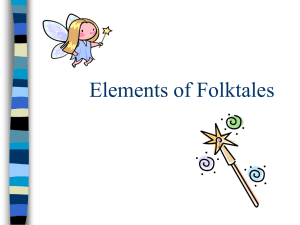
![Essay #4: [4 Short essays will substitute Essay 4]](http://s3.studylib.net/store/data/007737676_2-779981057889e025637152af438b827f-300x300.png)
